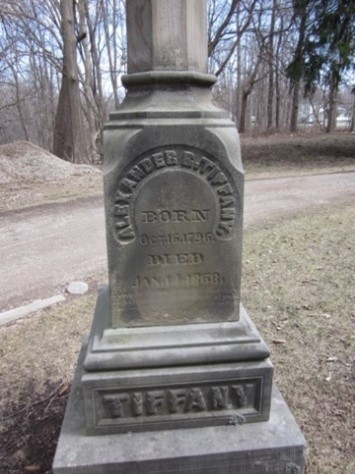
Alexander Tiffany, son of Sylvester Tiffany and Elizabeth Ralston, was born on October 16, 1796 at Niagara-on-the-Lake, Ontario, Canada. His brother-in-law, Rawlin Robinson, son of Gain Robinson, at age seventeen assisted with the printing of the Book of Mormon. His father Sylvester Tiffany was from Massachusetts and graduated from Dartmouth College.
When Alexander was young, his family moved to Canandaigua where his father ran the Ontario Freeman. Alexander learned the art of printing by setting type for the Canandaigua Constellation, also owned by his father. “Before he was tall enough to stand on the floor and reach the type in the case, he would sit on a high stool and set type for the paper.”
Alexander later studied law in the office of the Honorable John C. Spencer, one of the ablest and best lawyers in New York. Judge Spencer later became the Chief Justice of the Supreme Court of New York. After Alexander was admitted to the bar, he practiced law in Palmyra, New York. He was also a vestryman in the Zion Episcopal Church in Palmyra.[1]
Alexander was a man of small stature.[2] He never enjoyed robust health.[3] On September 3, 1823, he married Abigail Blackman Robinson, daughter of Gain and Chloe Robinson, in Palmyra. In that same year, he was appointed the first judge of Wayne County, New York. He remained in that office until failing health compelled him to resign. In June 1823, Alexander was admitted as an honorary member of the Wayne County Medical Society. He served as an attorney for that society.[4]
In 1826, he served the village of Palmyra as a clerk, inspector, justice of the peace, and a commissioner of schools.[5] When the Palmyra village was incorporated, he was one of two presiding justices.[6] From 1828 to 1829, Alexander served as a commissioner of the Common Schools in Palmyra.[7] In 1829, he also presided over the Court of Common Pleas and the Court of General Sessions of Peace. On May 26, 1829, it is presumed that Alexander was the judge in the case brought by Lucy Harris against Joseph Smith. The reason for the assumption is that he held court on the fourth Tuesday in January, May, and September.
In October 1832, Alexander and his family moved to Michigan, settling in Palmyra, Lenawee County.[8] His brother-in-law, Rollin Robinson, followed shortly thereafter. Lucy Mack Smith mentioned that “Robinson” informed Oliver Cowdery of a discussion he overheard, wherein several individuals planned to prevent the Book of Mormon from being published.
In 1833, Alexander was appointed an associate judge for Lenawee County. He was reappointed in 1834.[9] On March 27, 1833, Alexander was appointed the first postmaster in Palmyra, Lenawee County. By 1834, he was appointed a prosecuting attorney in Lenawee County.
On October 9, 1835, the Michigan Homestead and Cash Enter Patents Land Office in Detroit, claimed that Alexander had 3.11 acre. Alexander and Gains C. Robinson of Seneca County, Michigan, deposited in the General Land Office a certificate to register three acres of land. The land deed was signed by US President Andrew Jackson and Alexander Doniphan.[10]
In 1836, Alexander was elected Judge of probate, an office he held for eight years. In the 1840 US Federal Census, his residence was listed as Palmyra, Lenawee County. His household included one male age 5-9, two males ages 10-14, one male age 40-49, one female under age 5, 1 female age 5-9, two females ages 30-39, and one person employed as a professional engineer.
In 1843, Alexander entered a partnership with Fernando C. Beaman in Adrian, Michigan. In the community of Adrian, Thomas M. Cooley studied law under his tutelage.[11] From 1846 to 1850, Alexander was a county judge in Lenawee County.[12] In the 1850 US Federal Census, his residence was listed as Adrian, Lenawee County. His occupation was a lawyer. The value of his real estate was $1,000. Household members included Abigail Tiffany age 46, Alexander R. Tiffany age 24, Frances M. Tiffany age 18, George S. Tiffany age 16, and Margaret T. Tiffany age 5.
In 1850, Alexander was a member of the Michigan Constitutional Convention. By 1854, he was the leading member of the bar in Lenawee County.[13] In 1855, he wrote Tiffany’s Justice Guide and was elected to the Michigan State Legislature. In the legislature, he was appointed chairman of the judiciary committee.[14]
In 1860, Alexander wrote Form-Book for Attorneys in Michigan and Tiffany’s Criminal Law.
He died on January 14, 1868 in Palmyra, Lenawee County at age seventy-two. He was buried in Palmyra. At his passing, it was said of Alexander: “One of the best common law lawyers, a close student, a zealous and able advocate, an honest man; his memory is revered and held in warm affection by our people.”
In 1869, A Treatise on the Powers and Duties of Justices of the Peace in the State of Michigan under Chapter Ninety-three of the Revised Statues with Practical Forms was published posthumously. On January 25, 1873, his widow died at Tecumseh, Michigan.
[1] Cook, Palmyra and Vicinity, p. 253.
[2] Early History of Michigan, p. 638.
[3] Portrait and Biographical Album of Lenawee County, Michigan, p. 467.
[4] Landmarks of Wayne County, p. 121.
[5] Military History of Wayne County, p. 13.
[6] Military History of Wayne County, p. 183.
[7] “Palmyra Town Minutes,” 1828–1829.
[8] Memoirs of Lenawee County, p. 610.
[9] Early History of Michigan, p. 638.
[10] US General Land Office Records.
[11] Memoirs of Lenawee County, p. 605.
[12] Early History of Michigan, p. 638.
[13] Bench and Bar of Michigan, p. 412.
[14] Portrait and Biographical Album of Lenawee County, Michigan, p. 407.
